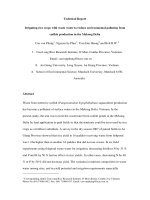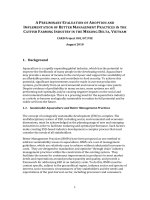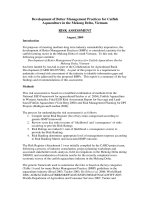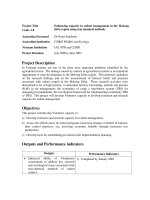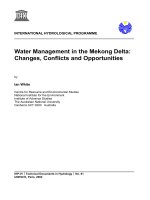Better Management Practices for Striped (Tra) Catfish Farming in the Mekong Delta, Vietnam
Bạn đang xem bản rút gọn của tài liệu. Xem và tải ngay bản đầy đủ của tài liệu tại đây (3.3 MB, 92 trang )
Better Management Practices
for Striped Catfish (tra)
Farming in the Mekong Delta,
Viet Nam
Version 3.0
May 2011
Nguyen Thanh Phuong
Nguyen Van Hao
Bui Minh Tam
Phan Thanh Lam
Vo Minh Son
Nguyen Nhut
Duong Nhut Long
Thuy- Nguyen TT
Geoff J. Gooley
Brett A. Ingram
Sena S De Silva
2
This document is prepared under the AusAID funded
Collaboration for Agriculture and Rural Development (CARD)
project, “Development of Better Management Practices for Catfish
Aquaculture in the Mekong Delta, Vietnam (001/07VIE)”
The project partners:
• Fisheries Victoria, Department of Primary Industries,
Victoria, Australia.
• Network of Aquaculture Centres in Asia-Pacific.
• Research Institute for Aquaculture No2, Viet Nam.
• Can Tho University, Viet Nam.
3
This document is Version 3.0 of “Better Management
Practices for Catfish Aquaculture in the Mekong Delta, Vietnam”. It
incorporates revisions of Version 2.0, which are based on feedback
and the experiences from the 11 demonstration farms that volunteered
to adopt the draft BMPs (Version 2.0), and the numerous consultations
that the project team has had with these farmers and other
stakeholders. It also incorporates revisions resulting from
consideration at the National CatFish BMP Workshop, 23/24
th
November 2010, Long Xuyen City, An Giang Province, involving all
stakeholders of the tra/striped catfish (Pangasianodon hypophthalmus)
farming sector of the Lower Mekong Delta.
In practice, the BMPs are to be provided to farmers in
‘handbook format’ (summarised version of this document) with
simple, Vietnamese translated language, together with standardised
record keeping booklets for on-farm use. This ‘BMP package’ is
effectively the primary dissemination material for farmers, and is
designed to facilitate industry-wide adoption and implementation of
BMPs in the catfish sector in Vietnam.
This document (Version 3.0) is divided into the following
parts:
• Part A: General background to Better Management
Practices (BMPs)
• Part B: BMPs for Grow-out
• Part C: BMPs for Hatcheries
• Part D: BMPs for Nurseries (=fry to fingerling rearing)
• Part E: General Aspects in Relation to BMPs
• Part F: Way forward
4
Table of Contents
Table of Contents 4
List of Tables 6
List of Figures 6
List of annexes 7
List of BMPs for grow-out farms 8
List of BMPs for hatcheries 9
List of BMPs for nurseries 9
List of general BMPs 10
PART A. GENERAL BACKGROUND TO BETTER
MANAGEMENT PRACTICES 11
1 What are Better Management Practices (BMPs) 12
2 The term "Better Management Practice" 15
3 Are BMPs needed for tra catfish farming? 16
3.1 Uniqueness of catfish farming in the Mekong Delta 16
3.2 The role of BMPs in tra catfish farming 17
4 The process(es) undertaken in the development of BMPs
for tra catfish farming 18
PART B. BMPS FOR GROW-OUT 22
1 General aspects 23
2 Pond siting and size 25
3 Pond preparation 25
4 Stocking 30
5 Day to day pond/stock management 35
5.1 Personal observations on the behavioural aspects of
the stock 36
5.2 Intake and discharge water management 36
5
5.3 Record keeping of water quality parameters 40
5.4 Feeding and feed management 41
5.5 Feed procurement and storage 43
5.6 Feeding 44
5.7 Mortalities 48
PART C. BMPs FOR HATCHERIES 56
1 Husbandry practices 57
1.1 Broodstock ponds 57
1.2 Broodstock conditioning 58
1.3 Spawning 61
1.4 Hatching/ Care of the hatchlings 62
2 Maintaining genetic diversity of broodstock 64
PART D. BMPs FOR NURSERIES 68
PART E. GENERAL ASPECTS IN RELATION TO BMPs . 74
1 Use of chemicals 75
2. Community responsibilities 76
3. Food safety and traceability 79
4. Market aspects 80
PART F. THE WAY FORWARD 83
1 Pathway to adoption of BMPs 87
2 Pathway to the formation of clusters/ associations 88
3 Industry Development Strategy 89
6
List of Tables
Table 1. The range in proximate composition of a random
selection of 12 commercial feeds, as specified on the
bags, used in catfish grow-out operations in the Mekong
Delta. The names of the producers are withheld for
ethical reasons (na - not available). 42
Table 2. Results of laboratory analysis on the proximate composition
of randomly selected commercial feeds and farm-made
feeds (FMF). The numbers in parentheses indicate the
number of feeds sampled 42
Table 3. Fertilisation rates, hatch rates, larvae to fry survival rates
and fry to fingerling survival rates during the peak and
off-season production periods. Values (in percentages)
represent range with mean and s.e. (±) in parentheses. 63
List of Figures
Figure 1. Figure depicting cluster/ society formations of shrimp
farmers over the years (from Umesh et al., 2009) 14
Figure 2. An impression of the concentration of catfish farms in
the Mekong Delta. Note the relatively uniform ponds 23
Figure 3. An example of the books used in record keeping in
shrimp farms, India. Error! Bookmark not defined.24
Figure 4. Common diseases found in catfish in the production
cycle. Rainfall (mm) are average values obtained from
nine provinces of the Mekong Delta. 49
Figure 5. The percent of ponds with different average tonnages at
harvesting in relation to a) area and b) the amount of
water (from Phan et al., 2009
4
) 54
Figure 6. Number or broodstock held on 45 striped catfish
hatcheries in the Mekong Delta in 2008, and % of these
stock that were broodstock, and % of broodstock that
were spawned. 59
7
Figure 7.Schematic diagram of a preferred broodstock genetic
management plan showing major activities of a
catfish hatchery 64
Figure 8. Schematic representation of the interrelationship among
hatchery, nursery and grow out sectors of the striped
catfish industry of the Mekong Delta, and movement
of stock between each sector. 69
List of annexes
Annex 1. The area surveyed by the CARD project for
describing catfish farming practices in the Mekong
Delta, Vietnam 91
Annex 2. List of chemicals/ products used for pond bottom and
water treatments (based on project survey results) 92
8
List of BMPs for grow-out farms
BMP 1. 1 Pond bottom treatment 28
BMP 1. 2. Liming 29
BMP 1. 3. Intake water 30
BMP 1. 4. Selection of seedstock for stocking 32
BMP 1. 5. Seedstock transportation 33
BMP 1. 6. Seedstock treatment and stocking 34
BMP 1. 7. Stocking density (SD) 35
BMP 1. 8. Water exchange 38
BMP 1. 9. Sludge management 39
BMP 1. 10. Improvement of pond water quality 40
BMP 1. 11. Monitor and record pond water quality and fish
mortalities 41
BMP 1. 12. Feed management when fish show a symptom of
‘whole yellow body’ or ‘jaundiced condition‘ 43
BMP 1. 13. Feed procurement and storage 44
BMP 1. 14. Feeding 45
BMP 1. 15. Fish health management 50
BMP 1. 16. Disease/dead fish management/ disposal 52
BMP 1. 17. Harvesting 53
9
List of BMPs for hatcheries
BMP 2. 1. Broodstock ponds 58
BMP 2. 2. Broodstock conditioning/ management requirements . 61
BMP 2. 3. Spawning 62
BMP 2. 4. Egg incubation/ hatching/ care of hatchlings 63
BMP 2. 5. Genetic management - Note that this BMP is only
applied for spawning batches that produce
potential broodstock 67
List of BMPs for nurseries
BMP 3.1. Pond preparation 70
BMP 3.2. Larval Stocking 71
BMP 3.3. Feeds and feeding regime 71
BMP 3.4. Feeds and water exchange 71
BMP 3.5. Fish health management 71
BMP 3.6. Harvest 72
BMP 3.7. Fry stocking 72
BMP 3.8. Feeds and feeding 72
BMP 3.9. Water exchange 73
BMP 3.10. Health management 73
BMP 3.11. Harvest 73
10
List of general BMPs
BMP 4. 1. Use of chemicals 76
BMP 4. 2. Community responsibility 77
BMP 4. 3. Environmental responsibility 78
BMP 4. 4. Food safety 79
BMP 4. 5. Traceability 80
11
PART A. GENERAL
BACKGROUND TO
BETTER MANAGEMENT
PRACTICES
12
1 What are Better Management Practices (BMPs)
BMPs refer to a set of standardised management guidelines
that are developed, based on existing practices and associated risks, as
determined in consultation with farming practitioners and relevant
industry stakeholders. Where appropriate, new innovations are also
routinely incorporated into BMPs to facilitate continuous
improvement in farming practices. Adoption of BMPs by farmers is
expected to lead to an improvement in effectiveness and efficiency of
farming practices, including improved water quality, reduced disease
risk, improved yields and product quality, and overall to contribute
towards sustainability of farming and economic viability of farmers.
BMPs are not designed for the purposes of achieving
certification per se. Rather, they are considered to apply at the ‘pre-
certification’ stage, after which farmers are likely to be better prepared
to comply with more stringent certification standards, should they
wish to proceed down this path for purposes of securing market
access. BMPs ensure that adoption of standardised management
guidelines is relatively easy to achieve without increased costs
1
,
2
. The
word “better” also implies that BMPs are always evolving as culture
practices progress. The BMPs therefore need to be revised
periodically to document and facilitate continuous improvements and
to capture farmer innovations and learnings from R&D.
Adoption of BMPs is known to bring about benefits in other
aquaculture sectors, such as:
• Reducing and/or minimising disease occurrence
• Improving growth performance
• Decreasing cost of farming (e.g. reduced feed and chemical
costs)
1
Umesh NR, Mohan ABC, Ravibabu G, Padiyar PA et al.(2009)Shrimp farmers in
India: Empowering small-scale farmers through a cluster-based approach. In:
Success Stories in Asian Aquaculture (eds SS De Silva & FB Brian Davy), pp43-
68. Springer, Dordrecht; NACA, Bangkok; IDRC, Ottawa.
2
CV Mohan and Sena S. De Silva, 2010.Better Management Practices (BMPs) -
gateway to ensuring sustainability of small scale aquaculture and meeting
modern day market challenges and opportunities. Aquaculture Asia, XV (No.1),
pp. 9-15.
13
• Improving pond and effluent water quality, and
consequently minimising impacts on the local environment
• Improving quality and marketability of produce
• Consolidating good relationships with local communities
through perception of industry’s commitment to good
environmental performance
• Facilitating long term industry sustainability overall.
Although most BMPs have an overall similarity in the
management objectives and guidelines, there is a significant level of
variation between commodities and locations. Development of
location specific BMPs and identification of industry and market
context are an important part of the development process of BMPs for
any one sector.
It is very clear that adoption of BMPs has brought about very
significant benefits to some farming systems, as best exemplified in
the case of the revival and the continued growth of shrimp farming in
Andhra Pradesh, India. In this instance, not only have the BMPs been
broadly adopted by individual farmers, the collective actions of farmer
‘clusters’ (through formation of farmer societies or ‘aquaclubs’) have
resulted in improved yields and minimised disease occurrences, and
brought about increased profits among other benefits. The results of
this development in India, including both adoption of BMPs and the
formation of clusters, are schematically depicted in Figure 1.
14
Figure 1. Figure depicting cluster/ society formations of shrimp
farmers over the years (from Umesh et al., 2009)
One question frequently asked by a wide range of stakeholders is:
“How do BMPs differ from other extension messages
commonly disseminated to farmers?”
BMPs are typically science-based management tools that are
developed from identifying the best existing farm practices, and
amending these as appropriate to address identifiable risks (analysed
concurrently). Interventions developed to address identified risk
factors are in the form of BMPs. Previously, aquaculture extension
messages have been most often focused only on ways to increase
production and quality of the product. BMPs have an overall goal of
promoting responsible and sustainable aquaculture, and not just
promoting higher production. Thus BMPs can help producers to farm
commodities in a more sustainable way, taking into account also
environmental and socio-economical considerations.
Good Aquaculture Practices (GAPs ) are commonly used to
address food safety issues in aquaculture. These tend to be farm
management practices designed to minimise the potential for farm-
raised fishery products to be contaminated with pathogens, chemicals,
15
or unapproved or misused veterinary drugs. GAPs can be defined as
those practices necessary to address food safety concerns, in isolation
of other farm management practices (which are typically also
addressed by BMPs).
BMPs are primarily practices adopted voluntarily at
individual farmer or farmer cluster (association) level, but can also
be used as a basis for local government regulations where broader
industry benefits are expected. As previously stated, they also have
the potential to facilitate farmer compliance with standards set by
third party certification programmes.
2 The term "Better Management Practice"
The term ’Better Management Practice‘ (BMP) is used in
several ways in the aquaculture sector. It can refer to the best-known
way to undertake any farm activity at a given time. In this sense, it
often refers to the practice or practices of only one or a very few
producers. A second way BMPs have been used is to describe a few,
often different, practices that increase efficiency and productivity
and/or reduce or mitigate negative environmental impacts. Finally,
BMPs are often required by government or other agencies and
institutions to encourage a minimum acceptable level of performance
(to eliminate bad practices) with regard to a specific on-farm activity.
In this sense, the term is used in opposition to unacceptable practices.
Previous studies have shown that a number of individual
BMPs relating to different on-farm activities vary by intensity, scale
and species. These practices were then analysed to understand how
they were developed (e.g. what problem did they solve and what result
did they achieve), how they work and what it would take for them to
be adopted by other producers. In the process of undertaking these
studies, it has become clear that many BMPs today still fall short in
both what is needed and what appears to be possible. In all likelihood,
today's BMPs will be tomorrow's norm, and constant review and
updating of BMPs is therefore required. The challenge is to encourage
further adoption of BMPs while at the same time promoting
continuous improvement.
In short, the goal must be to constantly seek out improved
BMPs, not just because they reduce negative impacts, but also because
they are more efficient and more profitable i.e. to improve the norm,
16
rather than to simply establish a ‘benchmark’, and declare everything
above to be best or good practice and everything below to be bad or
unacceptable. From the experience in India (this work was awarded
the Green Award by the World Bank in 2007), it is known that 'best'
practice does not apply in the industry at this time. However, BMPs
have been identified, and their positive impact on resource use
efficiency, on productivity, and importantly on profitability is
substantially better than from many previous experiences.
3 Are BMPs needed for tra catfish farming?
3.1 Uniqueness of catfish farming in the Mekong Delta
3
Tra catfish farming in the Mekong Delta occupies a rather
unique status in global aquaculture. The uniqueness of this farming
system could be summarised as follows:
- It is a farming system that is capable of producing, on
average, 300 - 400 tonnes /ha /crop; one of the highest recorded for
any primary production sector in the world.
• The industry essentially occupies approximately 5,400 ha
of land but produces, for example, as much as 65 % of the
total aquaculture production in Europe. It includes a range
of farming scales, from small, household-scale through to
large, industrial-scale enterprise.
• It provides many livelihood opportunities to poor rural
communities, particularly women in the related processing
sector, significantly bypassing that seen elsewhere in the
aquaculture industry around the world.
- It is a farming system that is mostly conducted in earthen
ponds of 4 - 4.5 m depth, with regular water exchange from the
Mekong River and/or its tributaries and canals.
• The farming system is blessed with an adequate water
supply through the year, but is also obligated to ensure that
the same water source is not overly loaded with nutrients
through effluent discharge; thereby bringing about negative
3
8°33’- 10°55’N; 104°30’- 106°50’E; 3.9x10
6
ha; 17 million population as at 2007
17
impacts on all downstream users of this common, valuable
resource.
- It is a farming system that for all intents and purposes is fully
integrated, with specialised hatchery production, nursery rearing (fry
to fingerling), and grow-out phases, and various post-harvest
activities, including processing for some larger, industrial-scale
producers.
- It is a farming system from which the produce is almost
totally destined for export, being an acceptable and affordable
substitute for ‘white fish’, particularly for western consumers.
3.2 The role of BMPs in tra catfish farming
This unique farming system has had its share of problems in
recent years, particularly in respect of diseases and marketing, at
various levels. Marketing problems are likely to intensify in the
foreseeable future. Most of all, the produce will have to meet
increasingly stringent food quality and production standards, resulting
indirectly from market globalisation and increasing demands of
consumers. It is also noted that many tra catfish producers, especially
small, household-scale farmers, presently do not have sufficient
negotiating power to influence the market chain. Fish price is often
determined independently by the buyers (processors), and so is
difficult for farmers to predict. It is in the above context that tra
catfish farming rather quickly needs to develop and adopt BMPs, to
facilitate use of acceptable farming practices and most of all to assist
in achieving market-based food quality standards while maintaining
environmental integrity. Adoption of BMPs, derived from science-
based studies and agreed upon by all stakeholders, is a most logical
way to meet the above challenges, and thereby ensure long term
sustainability of the sector. Furthermore, experience elsewhere
demonstrates that adoption of BMPs through farmer clusters
(including associations/aqua-clubs and/or an equivalent
organisational structure) is much more effective than for farmers
working in isolation. The cluster-based approach provides one voice
to the group, and enables better bargaining power, in respect of
purchases (e.g. feeds), marketing (e.g. negotiations with processors
or importers), and more rational (coordinated) use of water
resources. Collective action is a much more powerful tool overall,
18
and enables farmer access to government and policy makers in a much
more effective and coherent manner.
The sector, especially that represented by small, household-
scale farmers that own, operate and manage their farms, is
operating under much financial stress at the present time. Profit
margins have decreased in most instances, with fluctuating farm gate
prices and the prices of inputs, such as feeds, having increased
markedly. The ‘farm gate’ price is often below the ‘breakeven’ price
for farmers, making the practices unprofitable and difficult to
continue. The adoption of cluster-based BMPs will facilitate cost
reductions, and most likely provide a gateway to making farming
practices more economically and environmentally viable and
sustainable (see Mohan and De Silva, 2010).
4 The process(es) undertaken in the development of
BMPs for tra catfish farming
a) Stage 1
Realising the need to ensure the long term viability and
sustainability of the tra catfish farming sector in the Delta, a unique
system as it is, a collaborative consortium of the Network of
Aquaculture Centres of Asia-Pacific (NACA) and Department of
Primary Industries (Victoria, Australia), in conjunction with key
national counterparts, Research Institute for Aquaculture No. 2, (Ho
Chi Minh City) and College of Aquaculture and Fisheries, Can Tho
University (Can Tho City), proceeded to seek the required funding
under the joint funding initiative “Collaboration for Agricultural
Research and Development” (CARD) of AusAID (Government of
Australia) and the Ministry for Agriculture and Rural Development
(MARD; Government of Vietnam). The project entitled
‘Development of Better Management Practices for Catfish
Aquaculture in the Mekong Delta, Vietnam (001/07/VIE) was
commissioned by CARD in January 2008.
On availability of funds, the following Stage 1 activities were
undertaken between Feb 2008 and 2009:
- Planning meetings (HCMC and Can Tho) and technical
workshop, Can Tho University(CTU), 3-4 Dec. & 8-11 Dec., 2008.
19
- Participation in ‘Catfish Aquaculture in Asia’ international
symposium, CTU, 5-7 Dec., 2008.
- Design and test an industry survey questionnaire to
understand the details of the existing farming system and practices;
- Survey 94 grow-out farms (89 owners), 45 hatcheries and 47
nursery farms between February - May 2009, through farm visits and
discussion groups (See Annex 1 for area surveyed).
- Input the above data on farming practices using custom
designed database and analyse using available statistical packages,
and subjected to scientific scrutiny through publication in peer
reviewed journals
4
,
5
The following subsidiary activities which had a bearing on the
development of the draft BMPs were also undertaken:
• A Risk Assessment Procedure for tra catfish farming in the
Delta that incorporated the following elements:
Compile initial Risk Register (list of key risks)
categorised according to generic BMP framework, based
on the farm data collected;
Score and review key risks in terms of ‘likelihood’ and
‘consequence’ of risks occurring, to provide Risk
Ratings. Risk Ratings are ranked (= sum of likelihood +
consequence scores) to provide the Risk Ranking. Risk
Ranking determines appropriate level of management
response according to Risk Ranking Matrix and
associated BMP outcome.
4
Lam PT, Tam BM, Nguyen TTT, Gooley G, Ingram B, Hao NV, Phuong NT, De
Silva SS (2009). Current status of farming practices of striped catfish,
Pangasianodon hypophthalmus in the Mekong Delta, Vietnam. Aquaculture
296: 227-236.
5
Bui, Tam M., Phan, Lam T., Ingram, B.A., Nguyen, Thuy T.T., Gooley, G. J.,
Nguyen, Hao V., Nguyen Phuong V., De Silva, ,S. S., 2010. Seed production
practices of striped catfish, Pangasianodon hypophthalmus in the Mekong Delta
region, Vietnam. Aquaculture (in press)
20
• Based on the above, and numerous discussions with farmers
and other stakeholders, develop draft BMPs for catfish
farming in the Delta;
• Ten selected catfish farmers and four Provincial/ District
officials undertook a visit (June 2009) to witness and learn
from the organisation, functioning and effectiveness of
clusters (associations) of shrimp farmers in Andhra Pradesh,
India.
• Preparation of draft BMPs (Version 1.0) for consideration
by stakeholders as part of progressing to project Stage 2.
b) Stage 2
The draft BMPs (Version 1.0) entitled ”Development of Better
Management Practices for tra catfish farming in the Mekong Delta,
Vietnam” was translated into Vietnamese and distributed to many
stakeholders for comments, and formed the basis for discussions at
two stakeholder meetings held in Dong Thap and Can Tho provinces
on 6/7 and 9/10
th
of October 2009, respectively.
The stakeholder meetings were attended by catfish farmers of
all the provinces, processors, provincial, district and central
governmental officials, when each of the recommended BMPs were
discussed in detail, and feedback obtained.
Version 2.0 of the BMPs were then developed in which the
feedback from the two stakeholder meetings were incorporated, and
provided the base material for the preparation of dissemination of
BMPs to farmers, in a simple and comprehensible language. Version
2.0 of the BMPs also provided the basis for progressing to project
Stage 3.
c) Stage 3
At the Stage 2 stakeholder meetings, 11 farmers volunteered to
adopt the draft BMPs to varying degrees, from one or two ponds to
whole farms. These farmers were trained on-site by the project team,
and provided with a “practical” version of the BMPs and specially
designed booklets for record keeping. Apart from changing farming
practices, changes to on-farm infrastructure were also undertaken by
some farmers to facilitate compliance with BMPs. The farms were
21
visited on a fortnightly-monthly basis by the teams from Can Tho
University and RIA 2 to monitor water quality, record keeping and
overall management.
An evaluation survey on “Smallholder farmer’s reactions to the
implementation of BMP Demonstration trials” was undertaken in June
2010, as a component of a post-graduate study of the University of
Melbourne. This study provided further information for improving
the BMPs on tra catfish. This survey was also supplemented by visits
to the demonstration farms by the principal researcher and the project
team.
The next revision of the BMPs (Version 3.0) for catfish
farming in the Mekong Delta was based on all of these inputs, and was
presented for adoption at the National Workshop on 23/24
th
of
November, Long Xuyen City, An Giang Province. Version 3.0 of the
BMPs was subsequently published (this document) following
incorporation of minor amendments suggested at the National
Workshop in An Giang Province.
22
PART B. BMPS FOR
GROW-OUT
23
1 General aspects
In a practical sense, BMPs are applied to single farms.
However, experience shows that the clustering of farms as
organisational units (e.g. farmer cooperative, association, ‘aquaclub’
etc) in the management of common, multi-use resources greatly
enhances the results of BMP application i.e. increased likelihood of
leading to beneficial impacts on the individual farms which could not
otherwise have been achieved if actioned individually. In this context,
the BMPs take into account the advantages of clustering, and
recommendations are made with this principle underpinning the
adoption of BMPs for the tra catfish farming sector in the Delta.
It is recommended that a group of farms that are located in
the same geographical area or administration unit, or share a
common water supply source and/or outlet should form a cluster,
and jointly implement the same set of BMPs.
For example, as illustrated in Figure 3 farms within the frame
could function as a cluster.
Figure 2. An impression of the concentration of catfish farms in
the Mekong Delta. Note the relatively uniform ponds
24
Another important aspect of the application of BMPs is
accurate record keeping on all aspects of the implementation of
BMPs, including stock inventory, feeding, fish health management,
water management and water quality criteria. Record keeping is often
a cumbersome and time consuming process, and its use and
application may not be immediately evident. Complete and reliable
records are the key to finding answers and solutions when on-farm
problems occur. Here again, uniformity of record keeping within a
cluster ensures that records become comparable between farms. Note
that an adversary in one farm could impact on others, with time; hence
the importance of uniform record keeping through a cluster.
Record keeping also permits and facilitates compliance and
traceability, to demonstrate to buyers that the farms have adhered to
appropriate guidelines relevant to food safety and other market
requirements.
For example, where
BMPS have been adopted in
India, and a cluster approach
is functional, all records are
maintained in a uniform
manner, and as a
consequence the whole
cluster has been certified by
some independent agencies.
It is expected that
with the adoption of BMPs
for the catfish farming sector
in the Delta, a uniform
record keeping process will
be developed by producers in consultation with all the stakeholders. It
is proposed that the requisite documentation for adoption and
implementation of BMPs by farmers will include the BMP document
itself (also to be made available in convenient handbook format and in
plain language with Vietnamese translation) and associated data
record booklets; collectively to be referred to as the ‘BMP package’.
Figure 3. An example of the books
used in record keeping in shrimp
farms, India
25
2 Pond siting and size
Catfish farming has taken route along the river and its
branches in the Mekong Delta region. In essence, siting of farms is no
longer an issue as the farms are already functional, and it is unlikely in
view of real-estate prices that any new farms of substantial nature
would be developed in the future. In this context this document does
not endeavour to make recommendations on future farm siting. A
Google map (Figure 2) clearly indicates the intensity of farm locations
and pond layout in one location, which provides a fairly general
impression for the major catfish farming provinces in the Delta.
Established pond inlet and outlet infrastructure is incorporated into
this farming system, and very little change is possible. However,
industry should endeavour in most cases to simply improve upon the
existing system rather than attempt to re-locate or re-construct.
The extensive industry survey conducted in project Stage 1
4,5
gave an insight into the farm size distribution in the Delta. In general,
the pond size was relatively uniform throughout the Delta (see also
Figure 2). The farm size and the water surface area ranged from 0.2 to
30 ha (mean: 4.09 ha ± 0.48 se) and 0.12 to 20 ha (mean: 2.67 ha ±
0.33), respectively. The number of ponds per farm and pond size
ranged from one to 17 (mean: 4) and 0.08 to 2.2 ha (mean of mean:
0.61 ± 0.03 se), respectively. Approximately 72% of farms were less
than 5 ha, and only 9 % were 10 ha or greater in size. Large,
industrial-scale operations that are few in number and belong to
processing companies were not included in this survey.
Therefore, apart from industrial-scale farms, catfish farm
size for most producers in the Mekong Delta can be categorised as
being primarily small household-scale, with fewer large household-
scale. Moreover, the concentration of the farms in given localities,
and the fact that a great majority of the farms are owned, managed
and operated by families, make it feasible to introduce BMPs and
the formation of farmer clusters/ associations for smallholder tra
catfish farming in the Mekong Delta.
3 Pond preparation
Pond preparation is essential to reduce risks of disease
outbreaks, to obtain a healthy environment for growth of stock, and
therefore attaining better overall productivity.



